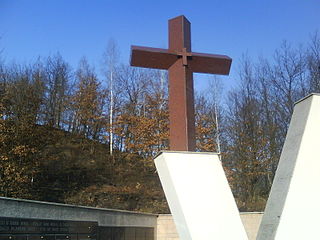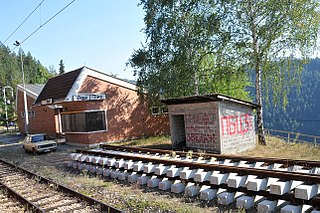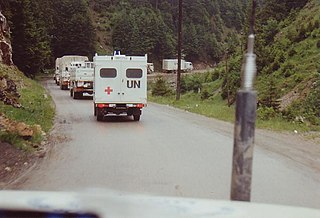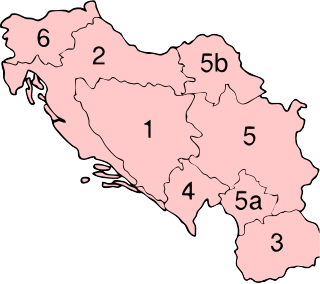 W
WThe Ahmići massacre was the culmination of the Lašva Valley ethnic cleansing committed by the Croatian Community of Herzeg-Bosnia's political and military leadership on Bosniak civilians during the Croat-Bosniak War in April 1993. It was the largest massacre committed during the conflict between Bosnian Croats and the Bosniak-dominated Bosnian government.
 W
WThe Bosnian War was an international armed conflict that took place in Bosnia and Herzegovina between 1992 and 1995. The war is commonly seen as having started on 6 April 1992, following a number of violent incidents earlier in the year. The war ended on 14 December 1995. The main belligerents were the forces of the Republic of Bosnia and Herzegovina and those of Herzeg-Bosnia and Republika Srpska, proto-states led and supplied by Croatia and Serbia, respectively.
 W
WThe Croat–Bosniak War was a conflict between the Republic of Bosnia and Herzegovina and the self-proclaimed Croatian Republic of Herzeg-Bosnia, supported by Croatia, that lasted from 18 October 1992 to 23 February 1994. It is often referred to as a "war within a war" because it was part of the larger Bosnian War. In the beginning, Bosniaks and Croats fought in an alliance against the Yugoslav People's Army (JNA) and the Army of Republika Srpska (VRS). By the end of 1992, however, tensions between Bosniaks and Croats increased. The first armed incidents between them occurred in October 1992 in central Bosnia. Their military alliance held out until early 1993 when their cooperation fell apart and the two former allies engaged in open conflict.
 W
WEthnic cleansing occurred during the Bosnian War (1992–95) as large numbers of Bosnian Muslims (Bosniaks) and Bosnian Croats were forced to flee their homes or were expelled by the Army of Republika Srpska and Serb paramilitaries. Bosniaks and Bosnian Serbs had also been forced to flee or were expelled by Bosnian Croat forces, though on a restricted scale and in lesser numbers. The UN Security Council Final Report (1994) states while Bosniaks also engaged in "grave breaches of the Geneva Conventions and other violations of international humanitarian law", they did not engage in "systematic ethnic cleansing" to the same degree as Bosnian Serb forces. According to the report, "there is no factual basis for arguing that there is a 'moral equivalence' between the warring factions".
 W
WThere was a campaign of ethnic cleansing in the area of the town of Foča committed by Serb military, police, and paramilitary forces on Bosniak civilians from 7 April 1992 to January 1994 during the Bosnian War. By one estimate, around 21,000 non-Serbs left Foča after July 1992.
 W
WThe Bosnian genocide refers to either the Srebrenica massacre or the wider crimes against humanity and ethnic cleansing throughout areas controlled by the Army of Republika Srpska (VRS) during the Bosnian War of 1992–1995. The events in Srebrenica in 1995 included the killing of more than 8,000 Bosniak men and boys, as well as the mass expulsion of another 25,000–30,000 Bosniak civilians by VRS units under the command of General Ratko Mladić.
 W
WThe Križančevo selo massacre occurred in Križančevo selo, a hamlet in the Lašva Valley in central Bosnia, where at least 14 Croat POWs and civilians were killed during an attack by the Army of the Republic of Bosnia and Herzegovina (ARBiH) on Croatian Defence Council (HVO) positions on 22 December 1993.
 W
WThe Lašva Valley ethnic cleansing, also known as the Lašva Valley case, refers to numerous war crimes committed during the Bosnian war by the Croatian Community of Herzeg-Bosnia's political and military leadership on Bosnian Muslim (Bosniak) civilians in the Lašva Valley region of Bosnia-Herzegovina. The campaign, planned from May 1992 to March 1993 and erupting the following April, was meant to implement objectives set forth by Croat nationalists in November 1991. The Lašva Valley's Bosniaks were subjected to persecution on political, and religious grounds, deliberately discriminated against in the context of a widespread attack on the region's civilian population and suffered mass murder, rape, imprisonment in camps, as well as the destruction of cultural sites and private property. This was often followed by anti-Bosniak propaganda, particularly in the municipalities of Vitez, Busovača, Novi Travnik and Kiseljak.
 W
WThe Siege of Mostar was fought during the Bosnian War first in 1992 and then again later in 1993 to 1994. Initially lasting between April 1992 and June 1992, it involved the Croatian Defence Council (HVO) and the Army of the Republic of Bosnia and Herzegovina (ARBiH) fighting against the Serb-dominated Yugoslav People's Army (JNA) after Bosnia and Herzegovina declared its independence from Yugoslavia. That phase ended in June 1992 after the success of Operation Jackal, launched by the Croatian Army (HV) and HVO. As a result of the first siege around 90,000 residents of Mostar fled and numerous religious buildings, cultural institutions, and bridges were damaged or destroyed.
 W
WOperation Neretva '93 was an Army of the Republic of Bosnia and Herzegovina (ARBiH) operation against the Croatian Defence Council (HVO) in September 1993 on a 200 km long front from Gornji Vakuf to south of Mostar, one of its largest of the year, on areas which were included in the Croatian Republic of Herzeg-Bosnia. The ARBiH did not achieve its objective to break through to southern Neretva valley and defeat the HVO in Herzegovina. During the operation dozens of Croat civilians were killed in the Grabovica and Uzdol massacres.
 W
WThe Siege of Bihać was a three-year-long siege of the northwestern Bosnian town of Bihać by the Army of the Republika Srpska, the Army of the Republic of Serbian Krajina and Bosniak dissenters led by the Bosniak politician Fikret Abdić during the 1992–95 Bosnian War. The siege lasted for three years, from June 1992 until 4–5 August 1995, when Operation Storm ended it after the Croatian Army (HV) overran the rebel Serbs in Croatia and northwest of the besieged town.
 W
WSilos was a concentration camp operated by the Army of the Republic of Bosnia and Herzegovina (ARBiH) during the Bosnian War. Centered around a windowless grain silo, it was used to detain Bosnian Serb, and to a lesser extent Bosnian Croat, civilians between 1992 and 1996. The camp was located in the village of Tarčin, near the town of Hadžići, 10 kilometres (6.2 mi) west of Sarajevo. Inmates were subjected to beatings, given little food and kept in unsanitary conditions. It had a full capacity of 600; 24 prisoners died or were killed while the camp was operational.
 W
WThe Štrpci massacre was the massacre of 19 civilians on 27 February 1993, taken from a Belgrade-Bar train at Štrpci station near Višegrad, on Bosnian territory. Fifteen Serbs were arrested in December 2014 and charged with war crimes for their participation in the massacre.
 W
WUnited Nations Security Council resolution 807, adopted unanimously on 19 February 1993, after reaffirming Resolution 743 (1992) and all subsequent relevant resolutions concerning the United Nations Protection Force (UNPROFOR), the Council determined that the situation in Bosnia and Herzegovina and Croatia continued to constitute a threat to international peace and security and therefore extended the mandate of UNPROFOR for an interim period ending 31 March 1993.
 W
WUnited Nations Security Council resolution 808, adopted unanimously on 22 February 1993, after reaffirming Resolution 713 (1991) and subsequent resolutions on the situation in former Yugoslavia, including resolutions 764 (1992), 771 (1992) and 780 (1992), the Council, after stating its determination to put an end to crimes such as ethnic cleansing and other violations of international humanitarian law, decided that an international tribunal should be established for the prosecution of persons responsible for serious violations of international humanitarian law committed in former Yugoslavia since 1991. This later became known as the International Criminal Tribunal for the former Yugoslavia.
 W
WUnited Nations Security Council resolution 815, adopted unanimously on 30 March 1993, after reaffirming Resolution 743 (1992) and all subsequent relevant resolutions concerning the United Nations Protection Force (UNPROFOR) including 802 (1993) and 807 (1993), the Council, acting under Chapter VII of the United Nations Charter, extended UNPROFOR's mandate for an additional interim period ending 30 June 1993.
 W
WUnited Nations Security Council resolution 816, adopted on 31 March 1993, after reaffirming resolutions 781 (1992), 786 (1992) concerning a ban on military flights over Bosnia and Herzegovina and recognising the current situation in the region, the Council, acting under Chapter VII of the United Nations Charter, extended the ban to cover flights by all fixed-wing and rotary-wing aircraft over the country, and to use all measures necessary to ensure compliance with the ban.
 W
WUnited Nations Security Council resolution 819, adopted unanimously on 16 April 1993, after reaffirming resolutions 713 (1991) and all (1992) subsequent resolutions, the Council expressed concern at the actions of Bosnian Serb paramilitary units in towns and villages in eastern Bosnia and Herzegovina, including attacks on civilians, the United Nations Protection Force and disruption to humanitarian aid convoys. The resolution marked the UN's first civilian "safe area" being declared; it failed to prevent the Srebrenica massacre.
 W
WUnited Nations Security Council resolution 820, adopted on 17 April 1993, after reaffirming all previous resolutions on the topic for a lasting peace settlement in Bosnia and Herzegovina and the region, the Council discussed the peace plan for Bosnia and Herzegovina and comprehensive steps to ensure its implementation.
 W
WUnited Nations Security Council resolution 824, adopted unanimously on 6 May 1993, after considering a report by the Secretary-General Boutros Boutros-Ghali pursuant to Resolution 819 (1993), the Council discussed the treatment of certain towns and surroundings as "safe areas" in Bosnia and Herzegovina.
 W
WUnited Nations Security Council resolution 827, adopted unanimously on 25 May 1993, after reaffirming Resolution 713 (1991) and all subsequent resolutions on the topic of the former Yugoslavia, approved report S/25704 of Secretary-General Boutros Boutros-Ghali, with the Statute of the International Tribunal as an annex, establishing the International Criminal Tribunal for the former Yugoslavia (ICTY).
 W
WUnited Nations Security Council resolution 836 was adopted on 4 June 1993. After reaffirming Resolution 713 (1991) and all subsequent resolutions on the situation in the former Yugoslavia, the Council expressed its alarm at the continuing situation in Bosnia and Herzegovina and decided to expand the mandate of the United Nations Protection Force (UNPROFOR) by allowing it to use force to protect the "safe areas".
 W
WUnited Nations Security Council resolution 838, adopted unanimously on 10 June 1993, after reaffirming Resolution 713 (1991) and all subsequent resolutions on the situation in the former Yugoslavia and in particular Bosnia and Herzegovina, the Council discussed options for the deployment of international observers on the borders of Bosnia and Herzegovina to ensure implementation of previous Security Council resolutions.
 W
WUnited Nations Security Council resolution 847, adopted unanimously on 30 June 1993, after reaffirming Resolution 743 (1992) and subsequent resolutions relating to the United Nations Protection Force (UNPROFOR), the Council condemned military attacks in Croatia and Bosnia and Herzegovina and extended the mandate of UNPROFOR until 30 September 1993.
 W
WUnited Nations Security Council resolution 857, adopted unanimously on 20 August 1993, after recalling 808 (1993) and 827 (1993) and considering the nominations for Judges of the International Criminal Tribunal for the former Yugoslavia received by the Secretary-General Boutros Boutros-Ghali before 16 August 1993, the Council established a list of candidates in accordance with Article 13 of the Statute of the International Tribunal.
 W
WUnited Nations Security Council resolution 859, adopted unanimously on 24 August 1993, after recalling all resolutions on the situation in Bosnia and Herzegovina, the Council noted that, despite all previous Security Council resolutions since Resolution 713 (1991), the region was still a scene of hostilities and there was little compliance with previous resolutions, particularly by the Bosnian Serb party.
 W
WUnited Nations Security Council resolution 869, adopted unanimously on 30 September 1993, after reaffirming Resolution 743 (1992) and subsequent resolutions relating to the United Nations Protection Force (UNPROFOR), the Council extended its mandate for a further 24 hours until 1 October 1993.
 W
WUnited Nations Security Council resolution 870, adopted unanimously on 1 October 1993, after reaffirming Resolution 743 (1992) and subsequent resolutions relating to the United Nations Protection Force (UNPROFOR), the Council, acting under Chapter VII of the United Nations Charter, extended UNPROFOR's mandate for additional period terminating 5 October 1993.
 W
WUnited Nations Security Council resolution 871, adopted unanimously on 4 October 1993, after reaffirming resolutions 713 (1992) and 743 (1992) and subsequent resolutions relating to the situation in the former Yugoslavia and United Nations Protection Force (UNPROFOR), the Council expressed concern that United Nations peacekeeping plan for Croatia, in particular Resolution 769 (1992), had not been implemented and went on to discuss the peace plan and extend UNPROFOR's mandate until 31 March 1994.
 W
WThe Battle of Žepče was a battle between Army B&H and HVO in Žepče, Bosnia and Herzegovina on the 24th of June 1993. The 319th Mountain Brigade which was located in the city found itself surrounded while other brigade of Army B&H took over high ground around city. Žepče was defended by HVO 111th xp Žepče brigade and Andrija Tadić battalion. After six days of fighting for Žepče, on 30 June Galib Dervišević agrees to surrender of 305th and 319th Brigade after which brigades ceases to exist.